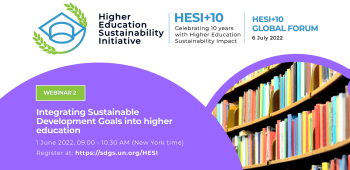Targets and Indicators

4.1
By 2030, ensure that all girls and boys complete free, equitable and quality primary and secondary education leading to relevant and effective learning outcomes
4.1.1
Proportion of children and young people (a) in grades 2/3; (b) at the end of primary; and (c) at the end of lower secondary achieving at least a minimum proficiency level in (i) reading and (ii) mathematics, by sex
4.1.2
Completion rate (primary education, lower secondary education, upper secondary education)

4.2
By 2030, ensure that all girls and boys have access to quality early childhood development, care and pre-primary education so that they are ready for primary education
4.2.1
Proportion of children aged 24–59 months who are developmentally on track in health, learning and psychosocial well-being, by sex
4.2.2
Participation rate in organized learning (one year before the official primary entry age), by sex

4.3
By 2030, ensure equal access for all women and men to affordable and quality technical, vocational and tertiary education, including university
4.3.1
Participation rate of youth and adults in formal and non-formal education and training in the previous 12 months, by sex

4.4
By 2030, substantially increase the number of youth and adults who have relevant skills, including technical and vocational skills, for employment, decent jobs and entrepreneurship
4.4.1
Proportion of youth and adults with information and communications technology (ICT) skills, by type of skill

4.5
By 2030, eliminate gender disparities in education and ensure equal access to all levels of education and vocational training for the vulnerable, including persons with disabilities, indigenous peoples and children in vulnerable situations
4.5.1
Parity indices (female/male, rural/urban, bottom/top wealth quintile and others such as disability status, indigenous peoples and conflict-affected, as data become available) for all education indicators on this list that can be disaggregated

4.6
By 2030, ensure that all youth and a substantial proportion of adults, both men and women, achieve literacy and numeracy
4.6.1
Proportion of population in a given age group achieving at least a fixed level of proficiency in functional (a) literacy and (b) numeracy skills, by sex

4.7
By 2030, ensure that all learners acquire the knowledge and skills needed to promote sustainable development, including, among others, through education for sustainable development and sustainable lifestyles, human rights, gender equality, promotion of a culture of peace and non-violence, global citizenship and appreciation of cultural diversity and of culture’s contribution to sustainable development
4.7.1
Extent to which (i) global citizenship education and (ii) education for sustainable development are mainstreamed in (a) national education policies; (b) curricula; (c) teacher education and (d) student assessment

4.a
Build and upgrade education facilities that are child, disability and gender sensitive and provide safe, non-violent, inclusive and effective learning environments for all
4.a.1
Proportion of schools offering basic services, by type of service

4.b
By 2020, substantially expand globally the number of scholarships available to developing countries, in particular least developed countries, small island developing States and African countries, for enrolment in higher education, including vocational training and information and communications technology, technical, engineering and scientific programmes, in developed countries and other developing countries
4.b.1
Volume of official development assistance flows for scholarships by sector and type of study

4.c
By 2030, substantially increase the supply of qualified teachers, including through international cooperation for teacher training in developing countries, especially least developed countries and small island developing States
4.c.1
Proportion of teachers with the minimum required qualifications, by education level
Progress and Info
SDG4 is a key enabler of most other SDGs. Unfortunately, global progress in education has not been fast enough. Only 58% of students worldwide achieved at least the minimum proficiency level in reading at the end of primary schooling in 2019. A large share of countries is moving backwards in learning outcomes at the end of lower secondary school. Improvement in upper secondary completion rate has slowed since 2015. Some regions, including sub-Saharan Africa, are facing teacher shortages, high student-teacher ratios, and inadequate training and lack of professional development opportunities for teachers. Accelerating progress towards SDG 4 should be prioritized as it will have a catalytic impact on achieving the overall 2030 Agenda.
Target 4.1: Completion rates in primary and lower secondary level education continue on an upward curve while the percentage of young people completing upper secondary school increased from 53% in 2015 to 59% in 2023. This increase, however is at a slower pace relative to progress in the preceding eight[1]year period and such improvements do not always result in positive learning outcomes. Between 2018 and 2022, based on learning outcomes at the end of lower secondary school across 81 OECD and partner countries, mean performance in mathematics fell by a record 15 points while in reading fell 10 points. However, reading and mathematics scores had been declining for these countries prior to 2015, suggesting that COVID-19 explains only part of the decline. A complex set of factors affect the education systems of upper-middle[1]income and high-income countries.
Target 4.2: Data from 76 mainly low- and middle-income countries from 2015 to 2023 shows that approximately two-thirds of young children are developmentally on track, with no significant gender differences. However, there are wide variations among countries and regions. In 2022, globally, 7 out of 10 children participated in organized learning one year before reaching official primary school age. Despite a 1.5 percentage point decline during the COVID-19 pandemic, participation levels have started to recover and return to pre-pandemic levels.
Target 4.3: In countries with recent data, around one-sixth of individuals aged 15-64 have participated in education and training. Participation is significantly higher among youth aged 15-24 compared to those aged 24-55, with an average participation rate of nearly 50% across most regions. However, less than 3% of older adults aged 25-55 engage in education and training in most regions.
Target 4.5: Socioeconomic disparities are prevalent in education, affecting various indicators. Global and regional parity ratios may hide gender inequalities within countries, disadvantaging either girls or boys. Disparities based on location or household wealth are more pronounced, with rural or less affluent families facing greater challenges. These gaps widen at higher education levels, leading to increased dropout rates and fewer opportunities for those from disadvantaged backgrounds.
Target 4.a: Only half of all primary schools have the basic infrastructures and materials to provide an adequate schooling experience to pupils with disabilities and one in five primary schools globally does not have single-sex sanitation facilities. On average, 44% of primary schools, 56% of lower secondary schools and 69% of upper secondary schools had access to Internet in 2022, almost double the rates in 2021. At the upper secondary level, 91% of schools have access to electricity, 81% have computers for pedagogical use and 69% of schools are connected to the internet.






